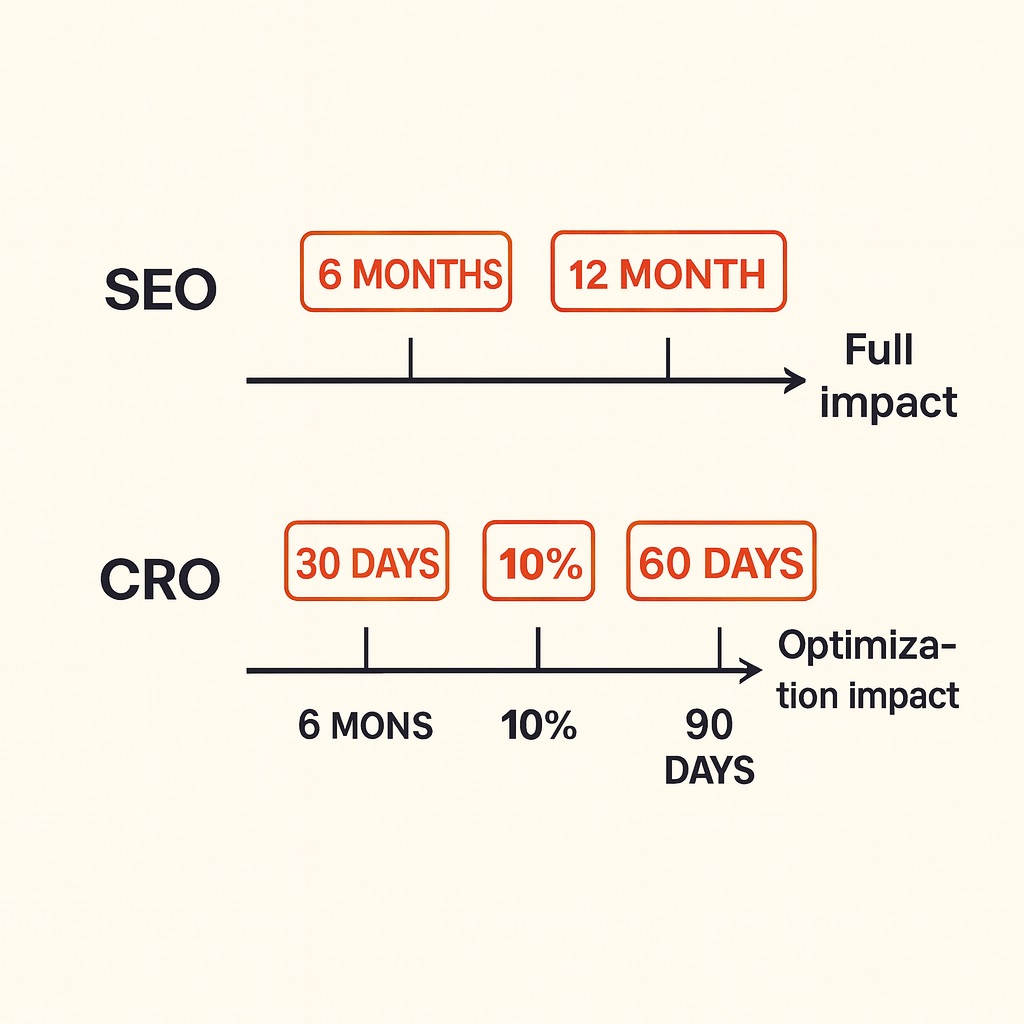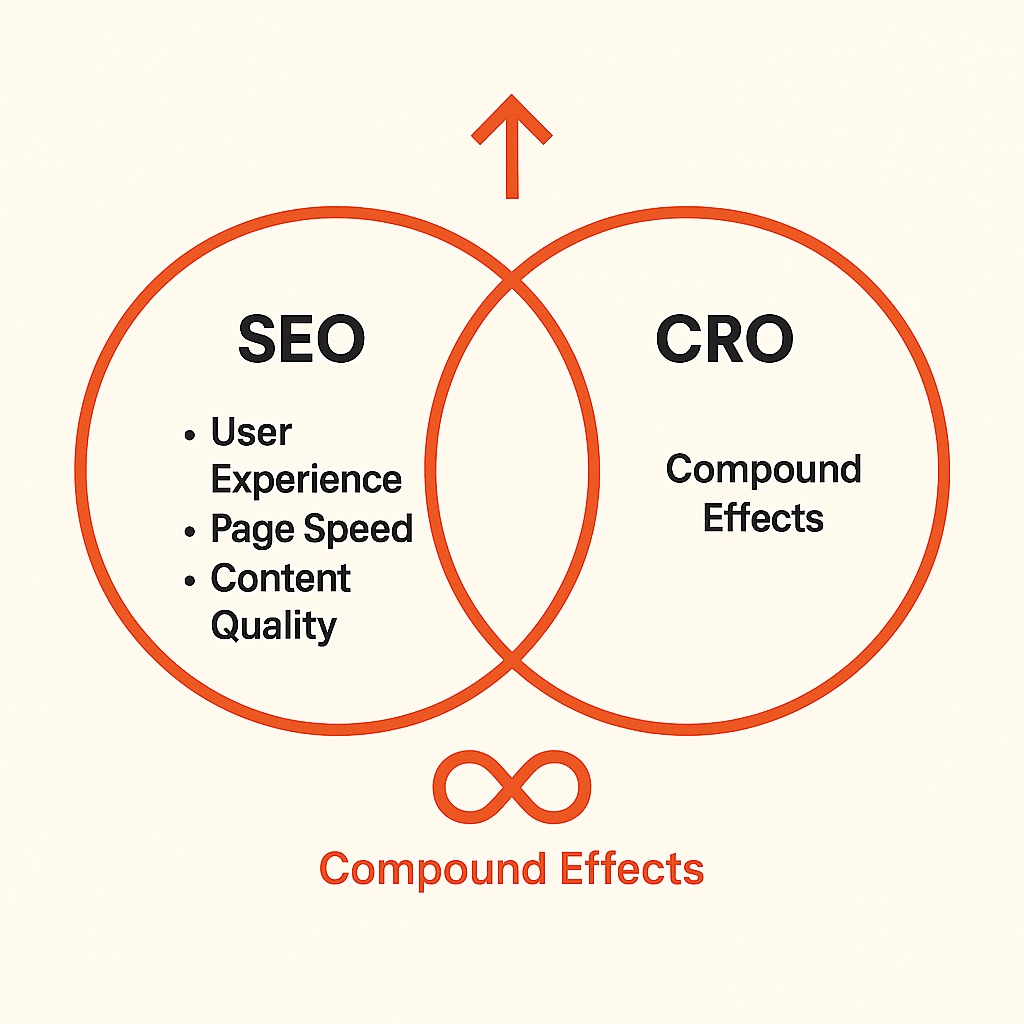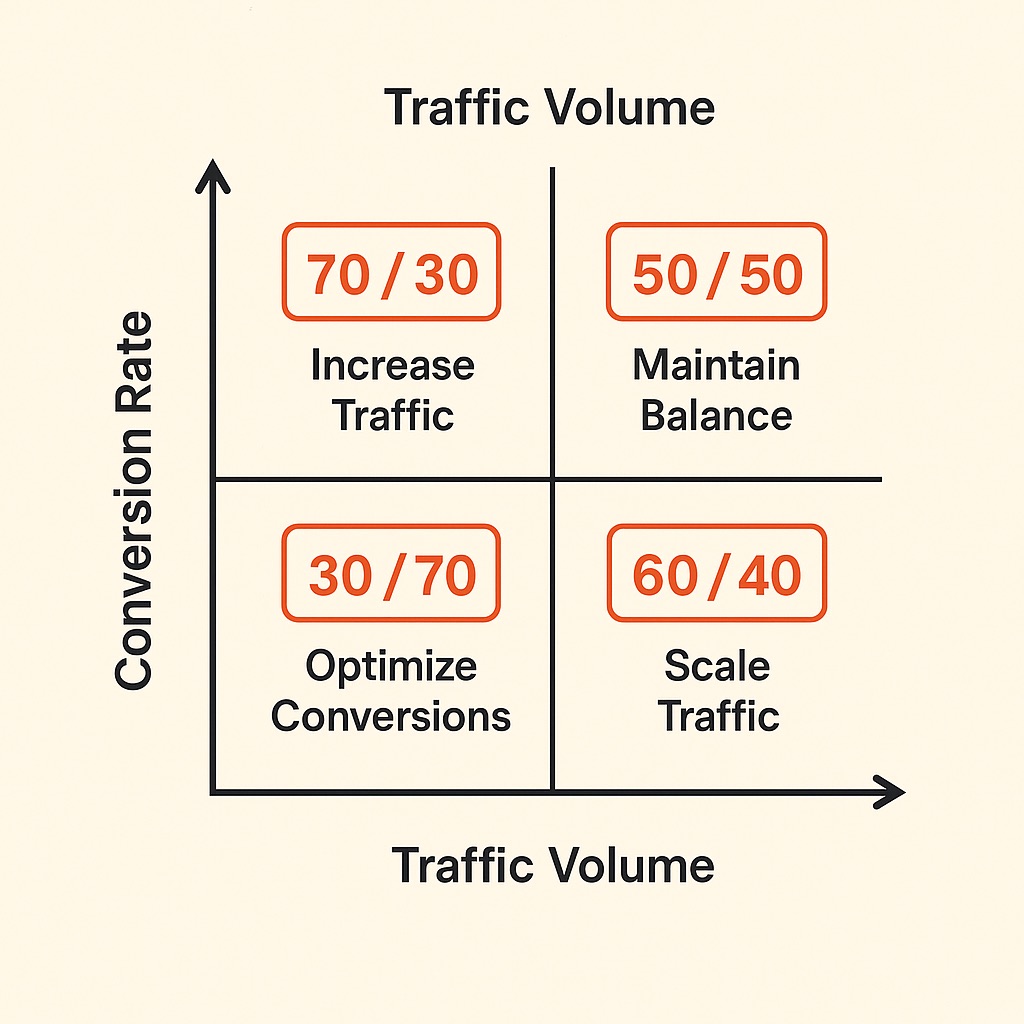The eternal question in eCommerce growth strategy: Should you focus on driving more traffic to your site or converting the visitors you already have? This isn’t just an academic debate—it’s a critical strategic decision that determines where you invest your limited time, budget, and resources.
Most eCommerce businesses approach SEO and conversion rate optimization (CRO) as separate initiatives, often creating internal competition for resources. However, the most successful online retailers understand that the real power lies not in choosing between SEO and CRO, but in knowing when to emphasize one over the other based on your specific business situation.
Table of Contents
Understanding SEO and CRO for eCommerce

Before diving into strategic frameworks, it’s crucial to understand how SEO and CRO function differently in the eCommerce ecosystem and why each approach generates value through distinct mechanisms.
SEO: Driving Quality Traffic
Search engine optimization represents the foundation of sustainable eCommerce growth, building long-term visibility that compounds over time rather than requiring continuous investment like paid advertising.
Organic traffic acquisition and long-term visibility creates a valuable business asset that continues generating returns long after the initial optimization investment. Unlike paid channels that stop delivering traffic when you stop paying, SEO improvements build cumulative value.
Compound growth effects: 6-18 months to full impact reflect the time required for search engines to fully recognize and reward optimization efforts. This timeline requires patience but delivers increasingly powerful results as authority and rankings improve.
Cost-effectiveness: $2.75 cost per acquisition vs $5.00+ for paid demonstrates SEO’s superior efficiency once initial ranking positions are achieved. The gap between organic and paid acquisition costs typically widens over time as competition increases paid advertising expenses.
Brand authority and trust building through rankings creates indirect benefits that extend beyond direct traffic. High search visibility enhances brand credibility and supports other marketing channels through improved recognition and trust.
CRO: Maximizing Revenue from Existing Traffic
Conversion rate optimization focuses on extracting maximum value from current website visitors, delivering faster returns while improving the effectiveness of all marketing investments.
Immediate ROI potential: 30-90 days for conversion improvements makes CRO attractive for businesses needing quick revenue impact or working with limited cash flow timelines.
Customer experience enhancement across all channels means CRO improvements benefit not just organic traffic but also paid advertising, email marketing, and direct traffic performance.
Lower customer acquisition cost through better efficiency amplifies the value of every marketing dollar spent by increasing the percentage of visitors who become customers.
Revenue multiplication: 1% conversion improvement = 10%+ revenue increase demonstrates CRO’s powerful leverage effect. Small percentage improvements in conversion rates create disproportionately large business impact.
When to Prioritize SEO Over CRO

Certain business situations strongly favor SEO investment over CRO efforts, particularly when traffic volume represents the primary growth constraint rather than conversion efficiency.
Low Traffic Volume Scenarios
Less than 1,000 monthly organic visitors indicates insufficient sample sizes for meaningful CRO testing and suggests that visibility, not conversion efficiency, represents the primary growth barrier.
New website launches requiring visibility foundation need SEO investment to establish basic discoverability before optimization efforts can generate meaningful returns.
Competitive markets where traffic is prerequisite require significant search presence to compete effectively, making traffic generation the logical first priority.
Seasonal businesses building off-season awareness benefit from SEO’s long-term approach to maintaining visibility during low-demand periods and building authority for peak seasons.
SEO-First Strategy Indicators
High-quality traffic with conversion rates >2% (good baseline) suggests that the website effectively converts visitors but lacks sufficient traffic volume to drive significant revenue growth.
Strong product-market fit but awareness gaps indicates that demand exists but potential customers can’t find the business through search, making SEO the logical growth lever.
Content marketing competitive advantages such as unique expertise, proprietary data, or exceptional educational resources create opportunities for SEO success that should be maximized.
Long B2B sales cycles requiring multiple touchpoints benefit from SEO’s ability to build ongoing visibility and authority throughout extended decision-making processes.
When to Focus on CRO First
High traffic volumes combined with poor conversion performance create clear opportunities for CRO-first strategies that deliver rapid revenue improvements without additional traffic investment.
High Traffic, Low Conversion Scenarios
5,000+ monthly visitors with <2% conversion rates represents substantial missed revenue opportunities that CRO can address more quickly and cost-effectively than pursuing additional traffic.
Paid advertising driving significant qualified traffic suggests that traffic quality isn’t the issue, making conversion optimization the logical focus for improving campaign performance.
Good organic rankings with poor user experience indicates successful SEO efforts undermined by conversion barriers that prevent visitors from becoming customers.
Limited marketing budgets requiring efficiency maximization make CRO attractive because optimization improvements benefit all traffic sources simultaneously, maximizing the impact of every marketing dollar.
CRO-First Strategy Benefits
Faster revenue impact timeline (30-90 days vs 6+ months) makes CRO essential for businesses facing immediate revenue pressures or seasonal sales opportunities.
Better ROI on existing marketing investment multiplies the value of current traffic without requiring additional acquisition costs, improving overall marketing efficiency.
Improved customer lifetime value and retention often results from better user experiences that CRO optimization creates, extending benefits beyond initial conversion improvements.
Enhanced user experience benefits all traffic sources means CRO improvements boost performance across organic, paid, email, and direct traffic channels simultaneously.
The Integrated Approach: SEO + CRO Synergy
The most successful eCommerce businesses understand that SEO and CRO create powerful synergies when properly integrated, with each discipline enhancing the effectiveness of the other.
How SEO and CRO Work Together
Quality traffic provides statistical power for CRO testing enables more sophisticated optimization approaches through larger sample sizes and faster test completion times.
Conversion improvements support SEO through engagement signals create positive feedback loops where better user experiences improve search rankings, which drive more traffic for further optimization.
User experience optimization benefits both search rankings and conversions represents the ultimate win-win optimization opportunity, where single improvements drive multiple business outcomes.
Content strategy serves both search visibility and user education allows businesses to create content that attracts organic traffic while guiding visitors toward conversion decisions.
Shared Optimization Opportunities
Page speed improvements benefit rankings and conversions represent high-impact optimization areas where technical improvements drive both search performance and user experience simultaneously.
Mobile optimization critical for both SEO and user experience becomes essential as mobile traffic dominates eCommerce, affecting both search rankings and conversion rates.
Content quality enhancements improve rankings and engagement create opportunities to attract more organic traffic while better educating and persuading existing visitors.
Technical SEO supports conversion funnel efficiency through improved site architecture, internal linking, and page performance that benefit both search engines and users.
Budget Allocation Strategy Framework
Strategic resource allocation requires understanding your business stage, competitive position, and growth constraints to optimize the balance between traffic generation and conversion improvement efforts.
Resource Distribution Models Based on Business Stage
Startup Phase (70/30 SEO): Foundation building, brand awareness focuses on establishing basic discoverability and market presence before optimizing conversion performance.
Growth Phase (50/50 Balanced): Traffic scaling with conversion optimization maintains growth momentum while ensuring that increasing traffic volumes convert efficiently.
Optimization Phase (30/70 CRO): Efficiency focus with established traffic maximizes revenue from existing traffic sources when acquisition costs become prohibitive or market penetration reaches saturation.
Scale Phase (60/40 SEO): Expand successful conversion strategies returns focus to traffic growth once conversion optimization reaches diminishing returns, scaling proven approaches to new markets or segments.
ROI-Based Decision Making Process
Customer lifetime value vs acquisition cost analysis provides the financial framework for evaluating whether traffic generation or conversion improvement offers better returns.
Market competition and acquisition cost assessment influences the relative attractiveness of organic growth versus paid acquisition, affecting SEO vs CRO prioritization.
Time-to-revenue requirements and cash flow considerations determine how much emphasis to place on CRO’s faster returns versus SEO’s longer-term compound growth.
Team expertise and resource availability evaluation ensures that budget allocation aligns with internal capabilities and the realistic timeline for achieving results.
Case Study Examples: SEO vs CRO Approaches
Real-world examples demonstrate how different business situations call for distinct strategic emphases, with measurable outcomes that validate the decision-making framework.
SEO-First Success Case
Situation: New DTC brand, <500 monthly visitors, 3.2% conversion rate This scenario represented a classic low-traffic, high-conversion situation where visibility represented the primary growth constraint.
Strategy: 12-month content marketing focus, technical SEO foundation The approach prioritized educational content creation, technical optimization, and link building to establish basic search presence.
Result: 15x traffic growth, maintained 3.1% CR, 400% revenue increase Traffic growth from 500 to 7,500 monthly visitors while preserving conversion efficiency delivered substantial revenue improvement.
Timeline: 8 months to significant impact, 18 months to full results Initial improvements became visible after 8 months, with full optimization impact realized within 18 months of strategy implementation.
CRO-First Success Case
Situation: Established brand, 25K monthly visitors, 1.4% conversion rate This represented a high-traffic, low-conversion scenario where efficiency improvement offered the clearest path to growth.
Strategy: 6-month conversion optimization focus, checkout redesign The approach concentrated on user experience improvements, particularly checkout process simplification and trust signal enhancement.
Result: 2.8% conversion rate (+100%), same traffic, 95% revenue increase Doubling the conversion rate without traffic changes nearly doubled monthly revenue through efficiency improvements alone.
Timeline: 3 months to impact, 6 months to optimization completion Initial improvements appeared within 3 months, with full optimization benefits realized within 6 months.
Common Integration Mistakes to Avoid
Understanding potential conflicts between SEO and CRO efforts helps prevent optimization strategies from undermining each other and ensures that integrated approaches deliver compound benefits.
SEO Mistakes That Hurt Conversions
Keyword stuffing reducing content quality and readability creates content that ranks well but fails to engage or persuade visitors, improving traffic at the expense of conversion rates.
Technical optimizations that slow page speed represent misguided efforts that sacrifice user experience for minor SEO benefits, hurting both rankings and conversions long-term.
Over-optimization creating poor user experience occurs when SEO tactics become so prominent that they interfere with natural user behavior and purchase decision-making.
Ignoring conversion intent in content creation results in content that attracts traffic but fails to guide visitors toward purchase decisions or business outcomes.
CRO Mistakes That Hurt SEO
Site speed reduction from heavy conversion tools creates technical debt that undermines search rankings while potentially negating conversion improvements through poor user experience.
Content reduction harming organic search visibility occurs when optimization efforts remove content that supports search rankings in favor of minimal conversion-focused designs.
Technical changes affecting search engine crawlability can damage organic traffic when CRO implementations create technical barriers that prevent proper indexing.
A/B testing implementation blocking search engine access represents a technical mistake that can cause significant ranking losses if testing tools prevent search engines from accessing content.
Measuring Success Across Both Disciplines
Effective measurement requires unified analytics approaches that accurately attribute business outcomes to specific optimization efforts while providing insights for future strategic decisions.
Unified KPI Dashboard
Organic traffic growth and quality metrics track both volume and engagement indicators to ensure that traffic improvements translate into business value.
Conversion rate improvements by traffic source and device enable precise optimization targeting while revealing which efforts deliver the highest returns.
Revenue attribution to SEO and CRO efforts with proper attribution ensures accurate ROI calculation and informed budget allocation decisions for future investments.
Customer acquisition cost and lifetime value by channel provides the financial framework for evaluating optimization effectiveness and strategic priorities.
Long-term Growth Tracking
Compound SEO growth measurement over 12+ month periods captures the full value of optimization efforts that may not be visible in short-term analysis.
Conversion rate trend analysis and optimization impact identifies successful optimization patterns while revealing opportunities for continued improvement.
Market share evolution and competitive positioning measures broader business impact beyond immediate traffic and conversion metrics.
Brand recognition metrics and direct traffic growth captures indirect SEO benefits that support overall marketing effectiveness and business growth.
Frequently Asked Questions
How do I know if I should focus on SEO or CRO first? Analyze current traffic volume and conversion rate. If <1,000 monthly visitors: focus on SEO foundation. If >5,000 visitors with <2% conversion: prioritize CRO. Use the decision matrix for budget allocation guidance.
Can I do both SEO and CRO with a limited budget? Start with 80/20 allocation based on your priority area. Focus on overlapping optimizations (speed, mobile, content). Use free tools initially: Google Analytics, Search Console, basic heat mapping. Scale investment as you see results from initial efforts.
How long does it take to see results from each approach? SEO Results: 3-6 months for initial improvements, 6-18 months for full impact. CRO Results: 30-90 days for optimization impact, immediate for technical fixes. Combined Approach: 90 days for initial integrated results.
Should I pause SEO to focus entirely on CRO? Never completely stop SEO – maintain technical health and content. Reduce SEO investment temporarily, don’t eliminate entirely. SEO has compound effects that require consistent effort. Pausing SEO can lead to ranking losses difficult to recover.
How do Core Web Vitals affect both SEO and CRO? Page speed directly impacts Google rankings and user experience. Mobile performance affects both mobile search visibility and conversions. Site stability (CLS) influences both search quality signals and user trust. Optimize Core Web Vitals for compound SEO and CRO benefits.
How to Determine Your SEO vs CRO Strategy

- Analyze current monthly organic traffic and conversion rate
- Calculate customer acquisition cost and lifetime value
- Assess available budget and team resources
- Use decision matrix to determine optimal allocation percentage
- Implement integrated approach with regular performance reviews
Ready to optimize your SEO vs CRO strategy? Take our SEO vs CRO Strategy Assessment quiz to get personalized recommendations, or schedule a Free eCommerce Growth Strategy Consultation to discuss your specific situation.
